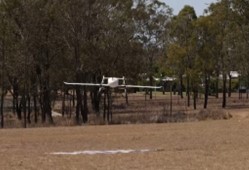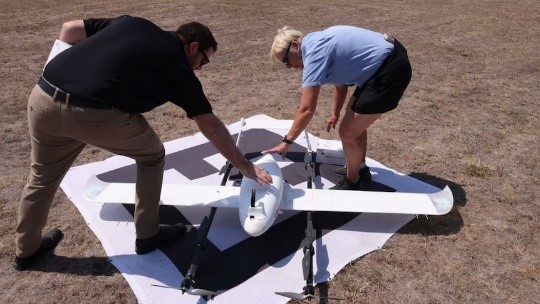ABC Southern Qld / By Tobi Loftus 3 December 2023
Darling Downs Health using drones to speed up patient treatment times in rural Queensland
Darling Downs Health staff have to load and unload the drone, but it is piloted remotely from Victoria.(ABC Southern Queensland)
abc.net.au/news/darling-downs-health-trial-drones-transporting-blood-tests/103177350
After having his eyes on the sky as a drone hobbyist for a decade, healthcare worker Dave Pugsley is turning his passion into a “game changing” development that may one day close the gap in outcomes for regional patients.
Key points:
- A Queensland health service is using a drone to fly blood tests between rural hospitals and a larger hub
- Health professionals say it is leading to faster treatment times for patients and improving regional outcomes
- The trial program will be expanded to more areas early next year
The Darling Downs Hospital and Health Service (DDHHS) in southern Queensland is trialling a high-tech drone to transport blood tests between rural hospitals and larger facilities to speed up testing and analysis.
Mr Pugsley, the service’s rural operations manager, said the drone saved precious time in getting results back to patients, meaning treatment could begin earlier.
“The faster that we can provide a diagnosis to a patient, the faster we can administer medicine or a treatment pathway,” he said.
The trial, which is funded by the federal government, is taking place in Queensland’s South Burnett region, with the drone flying samples from small hospitals like Nanango and Wondai to a larger base at Kingaroy Hospital.
“The drones are flying the specimens and pharmaceuticals into the Kingaroy hub in 15 minutes. We’ve halved the flying time,” Mr Pugsley said.
Freeing up staff
Nanango Hospital director of nursing Karen Cooke said they often had to rely on nurses to drive samples between hospitals.
“Our delivery truck had already left for the morning, so then we had a patient in ED [emergency department] that we were taking bloods off, and I said, ‘Great, we can put the bloods on the drone’,” Ms Cooke said.
“The patient said, ‘The drone?’.
“We’ve had patients go up and watch the drone land. They think it’s pretty exciting.”
Nanango Hospital is one of the oldest hospitals in Queensland and the trial is believed to be a state-first involving public hospitals.
It follows an ongoing trial in Goondiwindi, which involves pharmacies delivering medications to rural properties.
“We’re only a small hospital and we have a small number of staff, so if someone does have to take off to Kingaroy to pick up something or deliver something, it means that either operational staff or one of the nursing staff are down for at least an hour,” Ms Cooke said.

Flown remotely
What made the trial even more exciting for health workers was that the drone was flown remotely all the way from a facility in Melbourne, while a staff member on the ground in Kingaroy monitored local air traffic.
The DDHHS has a contract with Melbourne-based Swoop Aero, which has been using the technology all over the world, including in Malawi, Africa, where it delivers health products to hard-to-reach communities.
Mr Pugsley said they were using a drone known as the Kookaburra but were hoping to upgrade to a drone known as the Kite, which has a range of 175 kilometres, a 3-kilogram weight limit, and a cruising speed of 122 kilometres per hour.
The first phase of the trial was due to end last week.
Trial expanding
“What we would like to see is a flight from Kingaroy to Toowoomba, and then a scale-up effect to the rest of the Darling Downs,” Mr Pugsley said.
It takes approximately two hours to drive from Kingaroy to Toowoomba, but the drone promises to cut travel time to 40 minutes.
“It’s about getting tests faster to where they need to go, pharmacy where it needs to go, instruments, monitoring devices,” Mr Pugsley said.
“It’s not just about pathology or pharmacy, it’s about anything we can do to benefit Queenslanders west of Brisbane.”

